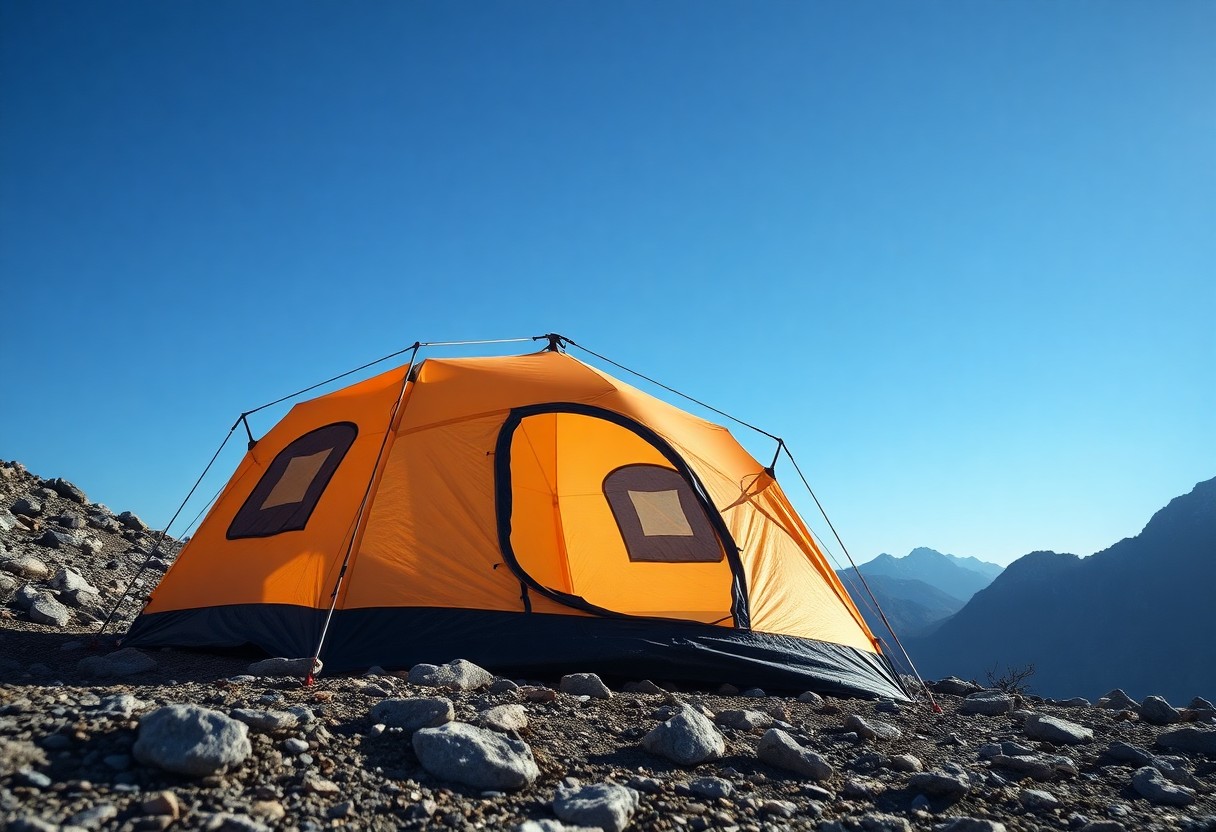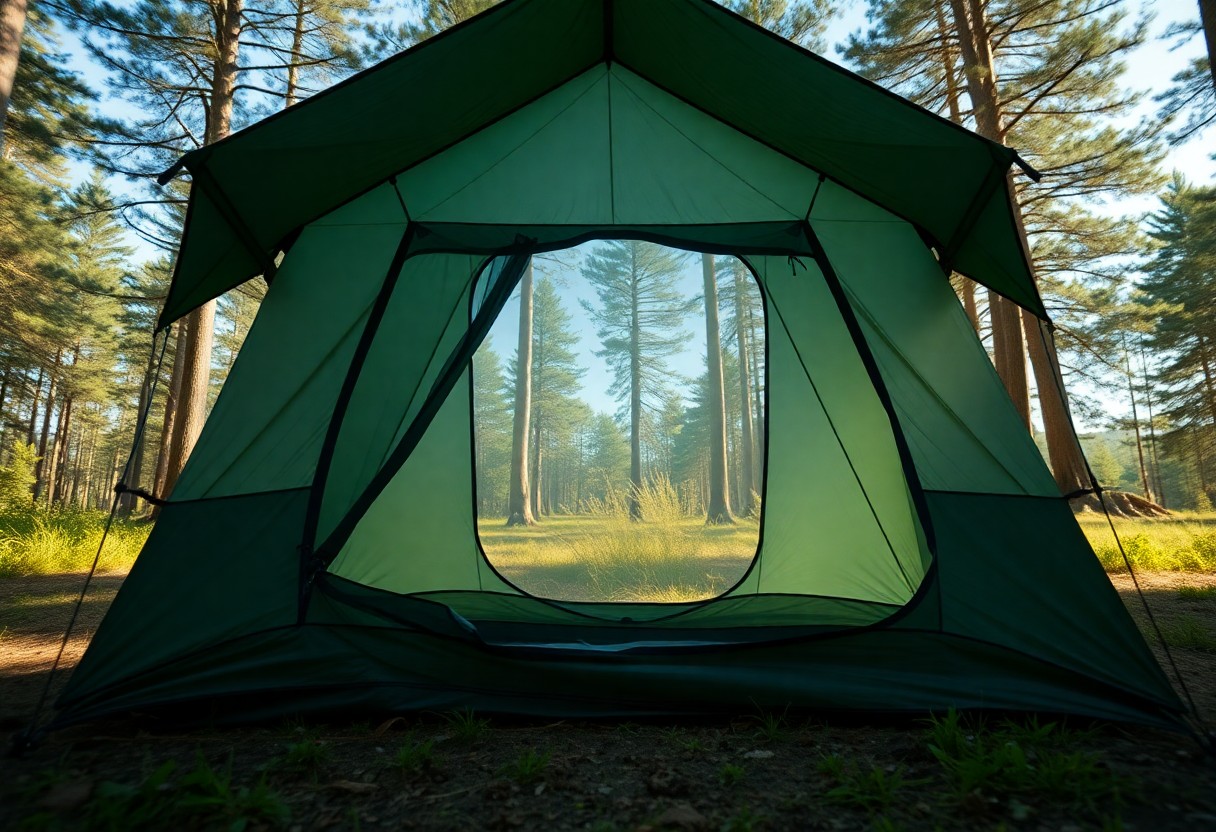Tent options can vary widely, and choosing the right one can significantly enhance your outdoor experience. In every season, it’s vital to prioritize features that ensure your comfort, safety, and protection from the elements. Whether you’re camping in summer heat or winter chill, consider aspects like insulation, ventilation, and waterproofing to keep you secure. This guide will help you navigate the most important characteristics to look for so that you can enjoy every camping adventure to the fullest.

Contents
- 1 Essential Structural Features for Year-Round Durability
- 2 Versatility and Adaptability: Configurations for All Terrains
- 3 Innovative Ventilation Systems: Comfort Across Climatic Conditions
- 4 Infrastructure Features for Every Camping Enthusiast
- 5 Safety Features That Every Tent Should Have
- 6 Conclusion
- 7 FAQ
- 7.0.1 Q: What materials should I look for in a camping tent?
- 7.0.2 Q: How important is waterproofing when selecting a tent?
- 7.0.3 Q: What size tent should I choose for my camping trips?
- 7.0.4 Q: Are ventilation features important in a camping tent?
- 7.0.5 Q: What seasonal features should a camping tent have?
Key Takeaways:
- Look for waterproof materials and sealed seams to ensure your tent remains dry during heavy rain or snow.
- Consider proper ventilation features like mesh panels and adjustable vents to prevent condensation buildup in varying climates.
- Choose a tent with a sturdy frame and durable poles to withstand strong winds and harsh weather conditions.
- Opt for a lightweight and easy-to-setup design for convenience, especially for backpacking trips or quick getaways.
- Check for added features like vestibules for gear storage and footprint compatibility for extra ground protection.
Essential Structural Features for Year-Round Durability
Your tent’s structure plays a vital role in its longevity and performance across seasons. Look for features such as a robust frame and quality stitching that can withstand the test of time and harsh weather. A well-designed tent should have a combination of materials that enhance strength while minimizing weight, ensuring you stay protected without being weighed down on your outdoor adventures. Opting for a tent with a good balance between stability and portability is key for both casual camping trips and more extreme excursions.
Importance of Tent Material and Construction
The material and construction of your tent are pivotal in determining its resilience against environmental stresses. High-denier fabrics often provide enhanced durability and tear resistance, while treatments like polyurethane coatings enhance waterproof capabilities. Additionally, features such as reinforced corners and double-stitched seams contribute to the overall strength of your tent, allowing it to maintain integrity during unpredictable weather. By prioritizing quality construction, you’re investing in a reliable shelter for your adventures.
The Role of Weather Resistance in Different Seasons
Your tent’s weather resistance significantly influences its performance throughout the year. In summer, a well-ventilated tent with UV protection can keep you cool and shielded from harmful rays, while in winter months, heat retention becomes imperative. Rain and strong winds require an effective waterproof system to ensure your gear stays dry. Various seasons come with distinct challenges, and understanding your tent’s weather resistance capabilities helps you select the right shelter for your camping needs, ensuring you remain comfortable and protected regardless of the conditions.
For instance, tents engineered with a high waterproof rating (measured in millimeters of water column) can better withstand torrential downpours, whereas options with thermal insulation can prevent heat loss during frigid nights. Additionally, tents equipped with tensioned rain flies and sturdy guylines remain stable during gusty winds, reducing the risk of collapse or damage. Choosing a tent that excels in these factors not only enhances your outdoor experience but also gives you peace of mind while you enjoy the great outdoors.
Versatility and Adaptability: Configurations for All Terrains
A versatile camping tent is your best ally for tackling various landscapes, from sandy beaches to rocky terrains. You’ll want a model that easily adapts to the environment, featuring adjustable ventilation, durable materials, and the ability to set up on uneven ground. Tents with multiple configurations allow for quick transformations, providing stability in windy areas while maximizing space and comfort. Being prepared for any situation enhances your outdoor experience, allowing you to focus on adventure rather than worrying about your shelter’s limitations.
The Benefits of Modular Designs
Modular tent designs offer customizable layouts that cater to different group sizes and needs, making them an excellent choice for families or friends camping together. By connecting additional room modules or using detachable sections, you can create a living space suited for comfort or a more compact setup for easy transport. This flexibility not only enhances your camping experience but also allows for efficient space management across varied terrains.
How to Choose Between Dome, Tunnel, and Cabin Styles
Each tent style has distinctly different profiles that cater to specific needs and terrain challenges. Dome tents, with their curved architecture, best resist wind and shed water effectively, making them ideal for inclement weather. Tunnel tents provide more living space and headroom, perfect for family camping, while cabin tents prioritize comfort, featuring vertical walls and separate rooms, suitable for extended trips. Consider how you’ll be using your tent, whether for quick weekend getaways or longer expeditions, as this will guide your choice.
Dome tents excel in windy or rugged locations due to their aerodynamic structure, minimizing resistance. If you prioritize weight and portability, they are often lighter and easier to pack. Tunnel tents maximize space for larger groups, making them great for social settings, offering tunnel-shaped designs that provide ample living room but can be less stable in high winds. On the other hand, cabin tents provide a homelike experience with vertical walls and a stand-up height, enhancing livability for extended stays. Base your decision on your camping style, group size, and terrain to find the perfect fit.
Innovative Ventilation Systems: Comfort Across Climatic Conditions
Advanced ventilation systems enhance your camping experience regardless of the weather. Designed to facilitate optimal airflow, these systems help regulate temperatures and improve comfort levels inside your tent. Look for features like mesh panels and specialized flaps that encourage air circulation, ensuring you stay cool during warm months and retain warmth when temperatures drop.
The Science of Airflow: Preventing Condensation
By employing innovative airflow techniques, modern tents minimize moisture build-up, which can lead to condensation inside. Tent designs often include rainfly and breathable fabrics that work together to allow moisture to escape while preventing water ingress. This balance keeps you dry and comfortable, enhancing overall camping enjoyment.
Adjustable Vents for Temperature Control
Adjustable vents play a pivotal role in maintaining a comfortable interior climate. With the ability to open or close these vents, you can regulate airflow depending on the weather conditions. Whether it’s a hot sunny day or a chilly evening, these vents allow for tailored ventilation, ensuring you remain comfortable throughout your trip.
| Customizable Airflow | Control the amount of fresh air and temperature in your tent. |
| Weather Resistance | Designed to prevent water ingress while maintaining airflow. |
| Strategically Placed | Located to enhance cross-ventilation and air distribution. |
Many modern tents come equipped with strategically designed adjustable vents that improve your camping experience. These vents can often be configured to suit your personal comfort needs, allowing you to manage humidity and heat effectively. For instance, a tent with side vents can draw cooler air from the ground, while upper vents release hot air rising within the tent, helping you maintain an ideal temperature. This level of adaptability is particularly beneficial for those who camp across various climates and seasons.
| Increased Comfort | Personalize your tent atmosphere to suit changing weather. |
| Enhanced Sleep Quality | Better airflow leads to a more restful night. |
| Versatile Use | Effective in all conditions, from summer heat to winter chill. |
Infrastructure Features for Every Camping Enthusiast
Quality infrastructure features in a camping tent can significantly enhance your overall experience. Beyond just providing shelter, these features ensure that your campsite remains organized and functional. Look for elements like dedicated storage options, ease of setup, and overall durability. A well-structured tent won’t merely withstand the elements but will also support you in making the most of your outdoor adventures.
Strategic Storage Solutions: Pockets and Gear Lofts
Pockets and gear lofts are crucial for keeping your camping crucials organized and easily accessible. These storage solutions help you make the most of your space, preventing clutter and creating a more pleasant environment inside the tent. Look for tents with multiple pockets or overhead gear lofts to conveniently store everything from headlamps to personal items, ensuring you can find what you need without frantically searching through your gear.
The Value of Quick Setup Systems
Quick setup systems can drastically cut down your time spent erecting the tent, which is especially valuable after a long day of hiking. Tents that utilize innovative technology such as pop-up features or color-coded poles simplified assembly, allowing you to enjoy your surroundings sooner. Imagine setting up camp in under five minutes, giving you more time to unwind, explore, or prepare a meal. Brands that incorporate these systems often receive rave reviews, as users appreciate how these features enhance their camping experience by streamlining the process on-site.

Safety Features That Every Tent Should Have
A reliable camping tent goes beyond comfort and weather resistance; it must also provide crucial safety features. These include fire retardant materials, which reduce the risk of flames spreading, and robust structures that withstand winds and harsh conditions. Additionally, adequate stake points and guy lines help secure the tent to the ground, maintaining stability during unpredictable weather. Investing in a tent with these safety features not only enhances your camping experience but also protects you and your loved ones in the great outdoors.
Fire Retardant Materials and Their Importance
Fire retardant materials are a significant aspect of tent safety, as they provide a vital barrier against the spread of fire. Tents made from these materials can slow down combustion rates, giving you precious extra seconds to react in an emergency. This feature is especially important if you plan to camp near open flames, such as a campfire or portable stove. Some reputable brands even provide certifications, so look for tents that meet standards set by organizations like the NFPA (National Fire Protection Association) to ensure maximum safety.
Stability and Security: Stake Points and Guy Lines
A well-constructed tent comes equipped with multiple stake points and guy lines that significantly enhance its stability. Proper stakes firmly anchor the tent to the ground, preventing it from being easily dislodged by wind or heavy rain. Meanwhile, guy lines, which attach to various points of the tent and are anchored to the ground, further distribute tension and lock the tent in place. As weather conditions can change quickly while you’re camping, a securely staked and stable tent reduces the risk of damage or personal injury, letting you enjoy the adventure with peace of mind.
Many tents now offer reinforced stake points that can withstand greater pressures compared to standard options. Additionally, different designs, such as “cross” or “A-frame” staking, can enhance wind resistance based on the predicted weather. Look for tents that provide extra guy lines for more extensive support, as this can reduce the chance of your tent collapsing under unexpected gusts. Whether you’re camping in serene forests or at windy mountain tops, your tent’s stability and security are pivotal for a safe outdoor experience.
Conclusion
The best camping tent features for every season are important for ensuring a comfortable and enjoyable outdoor experience. You should seek tents that provide adequate weather resistance, ventilation, and ease of setup, tailored to your specific climate and camping style. Durability and weight are also important considerations, as they impact both performance and transport. By choosing a well-rounded tent with these features, you can enhance your camping adventures and be prepared for whatever nature throws your way.
FAQ
Q: What materials should I look for in a camping tent?
A: When choosing a camping tent, it’s important to consider the fabric and poles. Look for tents made from durable materials such as ripstop nylon or polyester for the rainfly and tent body. These fabrics are lightweight and resistant to tears. For the tent poles, aluminum is a preferred choice as it provides strength without adding excessive weight, while fiberglass can be a more budget-friendly option but is generally less durable.
Q: How important is waterproofing when selecting a tent?
A: Waterproofing is a significant factor when selecting a tent, especially if you plan to camp in various weather conditions. Look for tents with a high waterproof rating, often measured in millimeters. A tent with a rating of at least 1500mm is suitable for light rain, while a rating of 3000mm or more is ideal for heavier downpours. Additionally, check for features like a rainfly, sealed seams, and a bathtub floor design that helps keep water out.
Q: What size tent should I choose for my camping trips?
A: The size of the tent you need will depend on the number of people sharing the tent and the gear you plan to store inside. As a general guideline, choose a tent that accommodates one more person than you expect to sleep. This extra space will ensure comfort, especially for storing equipment or if you have larger sleeping pads. If you’re camping with family or friends, consider how much gear you need to fit inside as well for practicality.
Q: Are ventilation features important in a camping tent?
A: Yes, ventilation is important for a camping tent. Adequate ventilation helps reduce condensation inside the tent, which can become uncomfortable and damp, especially in warmer weather. Look for tents that feature mesh panels, roof vents, and adjustable windows. These features allow for airflow while still keeping bugs out, ensuring a more comfortable sleeping environment during your camping trips.
Q: What seasonal features should a camping tent have?
A: The features of a camping tent can vary depending on the seasons you plan to use it during. For winter camping, look for four-season tents designed to withstand heavy snowfall and strong winds, often featuring lower profiles and stronger materials. For summer use, tents with ample mesh panels and good ventilation are ideal, and for spring and fall, consider versatile designs with removable rainflys for adaptability. Multi-season tents can provide a balance suitable for various weather conditions.



